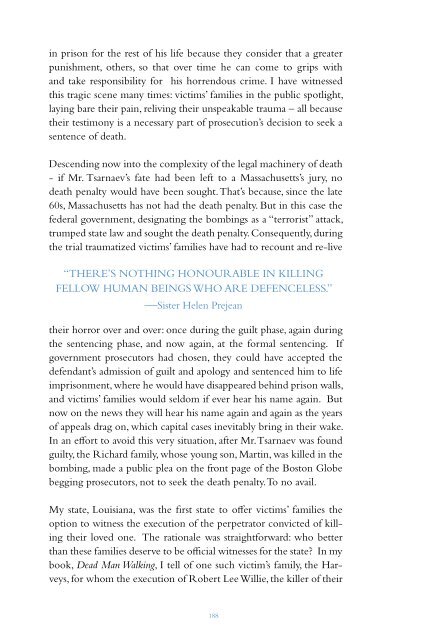PENALTY
DBk0302s7Xm
DBk0302s7Xm
Create successful ePaper yourself
Turn your PDF publications into a flip-book with our unique Google optimized e-Paper software.
in prison for the rest of his life because they consider that a greater<br />
punishment, others, so that over time he can come to grips with<br />
and take responsibility for his horrendous crime. I have witnessed<br />
this tragic scene many times: victims’ families in the public spotlight,<br />
laying bare their pain, reliving their unspeakable trauma – all because<br />
their testimony is a necessary part of prosecution’s decision to seek a<br />
sentence of death.<br />
Descending now into the complexity of the legal machinery of death<br />
- if Mr. Tsarnaev’s fate had been left to a Massachusetts’s jury, no<br />
death penalty would have been sought. That’s because, since the late<br />
60s, Massachusetts has not had the death penalty. But in this case the<br />
federal government, designating the bombings as a “terrorist” attack,<br />
trumped state law and sought the death penalty. Consequently, during<br />
the trial traumatized victims’ families have had to recount and re-live<br />
“THERE’S NOTHING HONOURABLE IN KILLING<br />
FELLOW HUMAN BEINGS WHO ARE DEFENCELESS.”<br />
—Sister Helen Prejean<br />
their horror over and over: once during the guilt phase, again during<br />
the sentencing phase, and now again, at the formal sentencing. If<br />
government prosecutors had chosen, they could have accepted the<br />
defendant’s admission of guilt and apology and sentenced him to life<br />
imprisonment, where he would have disappeared behind prison walls,<br />
and victims’ families would seldom if ever hear his name again. But<br />
now on the news they will hear his name again and again as the years<br />
of appeals drag on, which capital cases inevitably bring in their wake.<br />
In an effort to avoid this very situation, after Mr. Tsarnaev was found<br />
guilty, the Richard family, whose young son, Martin, was killed in the<br />
bombing, made a public plea on the front page of the Boston Globe<br />
begging prosecutors, not to seek the death penalty. To no avail.<br />
My state, Louisiana, was the first state to offer victims’ families the<br />
option to witness the execution of the perpetrator convicted of killing<br />
their loved one. The rationale was straightforward: who better<br />
than these families deserve to be official witnesses for the state? In my<br />
book, Dead Man Walking, I tell of one such victim’s family, the Harveys,<br />
for whom the execution of Robert Lee Willie, the killer of their<br />
daughter could not happen quickly enough. A week before Willie’s<br />
execution in the electric chair, Vernon Harvey held his own press<br />
conference, urging the authorities to “bring it on” and he wished he<br />
could be the one to “pull the switch.” What I’ll always remember (as<br />
spiritual advisor to the condemned, I was also present at the execution)<br />
is that immediately after the execution, members of the media<br />
asked Mr. Harvey if witnessing the execution had satisfied him, and<br />
he said, “Anybody got any whiskey? Anybody want to dance? We<br />
killed that SOB tonight, and I got to watch him die! Then he added:<br />
“But you know what? The SOB died too quick. I hope he burns<br />
in hell.” And as he said this he jerked his thumb downward over and<br />
over. As I heard him that night, I remember thinking to myself that<br />
this poor, distraught man could have watched his daughter’s murderer<br />
die a thousand times, and it would never be enough. And now that<br />
the object of his hatred was dead, where could all that pent-up rage<br />
of his go? My image of him that night is of a very thirsty man who<br />
had just drunk a long drink of salt water.<br />
I’ve been studying the death penalty in the U.S. for a very long time.<br />
I keep learning about it, and one of the key things I’ve learned about<br />
its application is that very few death sentences are actually handed<br />
down, and then, how exceptionally few murder victims’ families ever<br />
get to witness the execution of their loved one’s killer. And then it<br />
is almost exclusively reserved for those who kill people of European<br />
descent, almost never those who murder people of color. Evidently<br />
their lives, their deaths don’t seem to matter in the same way, no outrage<br />
is felt at their passing, and, often enough no serious investigation<br />
of their murders is pursued.<br />
When we do abolish the death penalty in the U.S. and we are now on<br />
our way toward that day as public support plummets and executions<br />
become more and more rare, a significant part of our enlightenment,<br />
I believe, will be the recognition that wounded, grieving families,<br />
after long years of waiting, can never be healed by watching as the<br />
government kills the perpetrator. If anything, witnessing such violence<br />
only serves to re-traumatize them. Such was the testimony of<br />
many murder victims’ families to the legislature in New Jersey as the<br />
state set about to repeal the death penalty in 2007, the first state to<br />
legislatively do so in the modern era. “Don’t kill for me” they said.<br />
188 189


